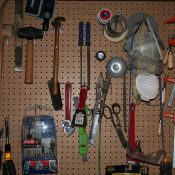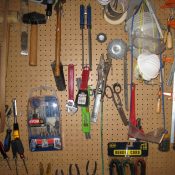Wondering lately where I want to land on the spectrum between convenience and quality when comparing an ultra-portable Canon PowerShot SD1100 IS (Digital Elph) and a Canon Rebel EOS. The PowerShot is the size of a deck of cards and weighs ounces. The Rebel (a DSLr camera) easily weighs five times more and has much more bulk – it’s not going to fit neatly into a belt holster that doesn’t get in your way while hiking or biking. I’m not eager to have several pounds dangling from my neck, but at the same time, wouldn’t mind stepping up my game quality-wise in the photo department. Neither camera at my disposal is the latest model in its respective line, but I assumed the Rebel would take far better pictures by default.
Decided to do an informal test to find out. Running both cameras in fully automatic mode (since that’s what I use most often, and since it’s the only way to compare fairly), I took a handful of shots in the back yard, attempting to make the images as close to identical as possible. Tried to get a range of shots in full sun, mixed shadow, and shadow. Included one flash shot and one macro shot as well.
One significant difference not accounted for here is the fact that the Rebel has a full range of manual options that the PowerShot doesn’t have. On the other hand, the PowerShot has a quite good movie mode, which the Rebel lacks completely.
The results weren’t nearly as clear cut as I expected. Comparing the images below, I have a fairly clear preference for one of the columns, but prefer a few images from the opposite column. Can you tell which column is which camera? Which column do you prefer overall?

|

|

|

|

|

|

|

|

|

|

|

|

|

|

|
 |


 Loose notes from the SXSW 2010 session
Loose notes from the SXSW 2010 session  Loose notes from SXSW 2010 session by social network researcher danah boyd:
Loose notes from SXSW 2010 session by social network researcher danah boyd: 
 Blog look different? At first glance, not by much, but I’ve just completed a massive cleanup of the back-end, replacing the old HTML/CSS with the
Blog look different? At first glance, not by much, but I’ve just completed a massive cleanup of the back-end, replacing the old HTML/CSS with the